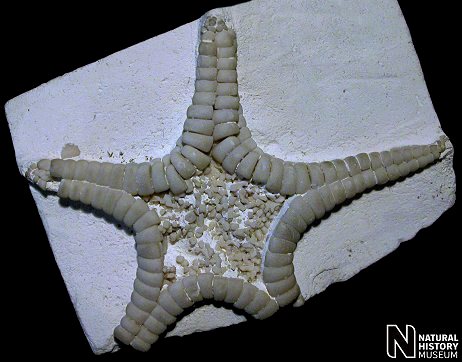
|
Nymphaster (Sladen, 1885) |
Medium to large starfish with long tapering arms demarked from the central disc. Though this group ranges throughout the Chalk, and isolated ossicles are not uncommon, complete specimens are amongst the rarest of chalk fossils. A number of species have been described, but the characters which distinguish these are very subtle and often only apparent in well preserved specimens. The marginal ossicles are quite non-descript, comprising simple blocks with a pitted outer surface.
Nymphaster can be distinguished from similar long-armed starfish of the Chalk by a combination of its square, blocky marginal ossicles, and the juncture of the superomarginals along the mid-line of the aboral surface of the arms. Pycinaster has more bulbous superomarginals, especially around the disc, whilst the superomarginals of Calliderma and Recurvaster meet part way up the arm, and the aboral ossicles of the disc extend up the arm between them.

1). Nymphaster marginatus; Aboral view of the small but superbly preserved type specimen, note how the superomarginals are in contact along the entire length of the arms (x2.0, White Chalk, near Bromley, Kent, BMNH (British Museum (Natural History) London) 35484. Image © 2005 The Natural History Museum, by kind permission.
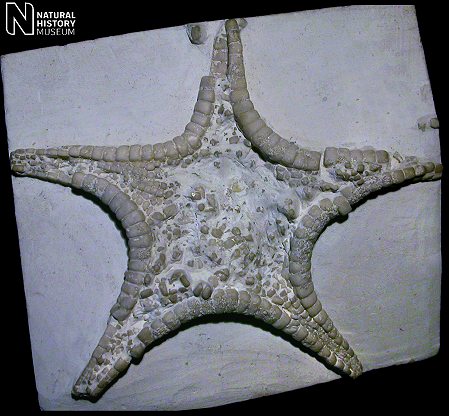
2). Nymphaster coombi; Oral view of the well preserved type specimen, note that the inferomarginals do not meet along the midline of the arms (x1.2, Turonian, Balcome Pit, Amberley, West Sussex, Dixon Collection, BMNH (British Museum (Natural History) London) 35503. Image © 2005 The Natural History Museum, by kind permission.
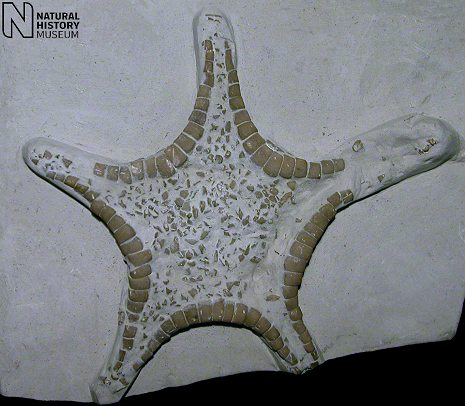
3). Nymphaster coombi; Oral view of a well preserved individual (x1.4, Grey Chalk, Folkestone, BMNH (British Museum (Natural History) London) E3349. Image © 2005 The Natural History Museum, by kind permission.
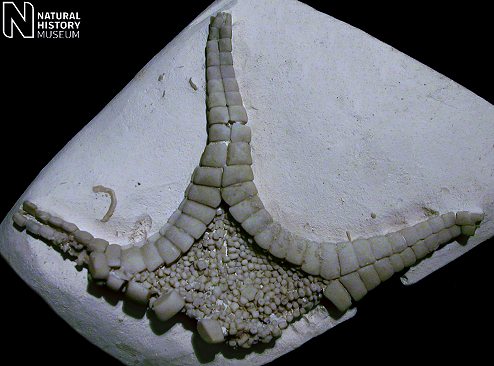
4). Nymphaster humilis; Aboral view of the large type specimen (x1.3, Seaford Chalk, North Foreland, Kent, Rowe Coillection, BMNH (British Museum (Natural History) London) E28407. Image © 2005 The Natural History Museum, by kind permission.
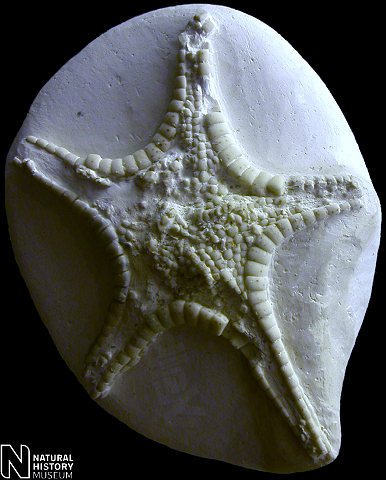 A A |
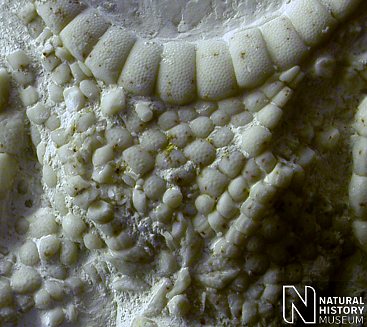 B
B |
5). Nymphaster coombi; (A) Oral surface (x1.6); (B) Detail of the oral surface of the disc, with semi-articulated adambulacral ossicles and jaw plates (x4.0, White Chalk, Charlton, Kent, BMNH (British Museum (Natural History) London), display specimen. Image © 2006 The Natural History Museum, by kind permission.
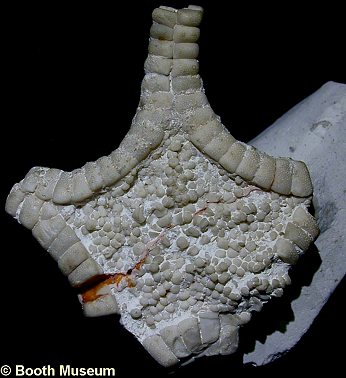 A A |
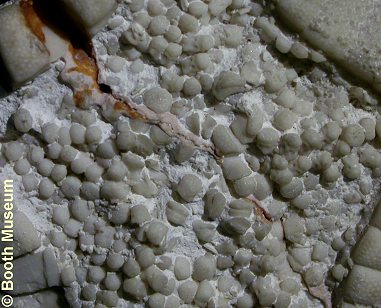 B
B |
6). Nymphaster cf. marginatus; Aboral views of an incomplete but exceptionally preserved specimen. (A) General view (x2.0); (B) detail of the aboral ossicles (x3.6). White Chalk, Potter Collection, Booth Museum, BMB 017044, by kind permission of John Cooper.
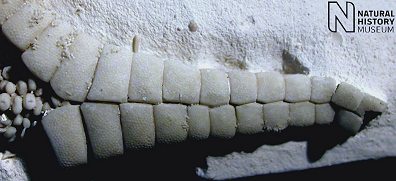 A A |
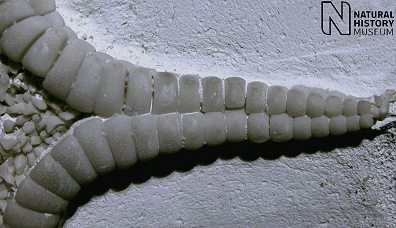 B
B |
7). Nymphaster humilis (A)(x2.3) and Nymphaster marginatus (B)(x3.7); Details of the type specimens showing the aboral surface of the arms. Both clearly display the characteristic Nymphaster arm morphology; they are long and tapering and the superomargials meet along the full length of the mid-line. (Recognising Nymphaster). Images © 2005 The Natural History Museum, by kind permission.
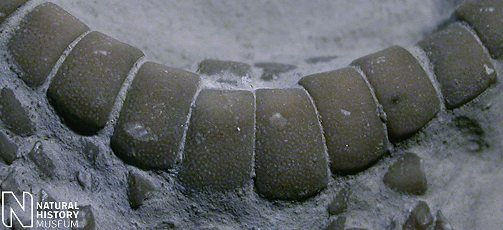
8). Nymphaster coombi; detail of the inferomarginals (x7.2, Grey Chalk, Folkestone, BMNH (British Museum (Natural History) London) E3349. Image © 2005 The Natural History Museum, by kind permission.
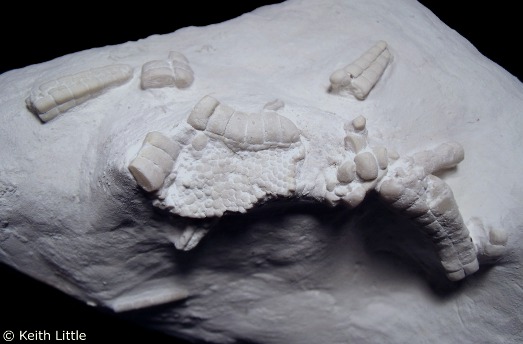
9). Nymphaster cf. humilis; Aboral view of a fragmented specimen (x1.8, Seaford Chalk, Thanet coast, Kent, in the collection of Keith Little). Image © 2012 Keith Little, by kind permission.
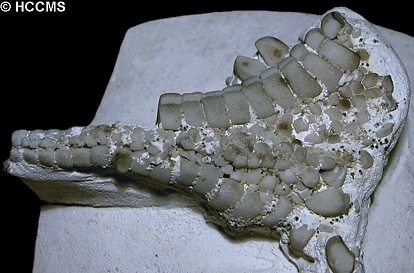 A A |
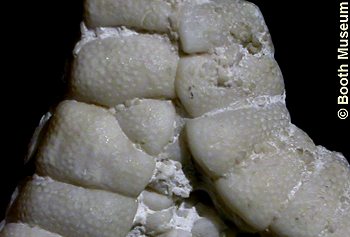 B B |
10). (A) Nymphaster cf. humilis; The oral surface a partial but well preserved specimen (x2.1, White Chalk, HCCMS (Hampshire County Council Museum's Service) collection, stored at Gosport Museum, G.1983.363, by kind permission of Dave Kemp, HCCMS). (B) Nymphaster cf. marginatus; Detail of the aboral surface showing a growth defect (x6.7, White Chalk, Potter Collection, Booth Museum, BMB 017044, by kind permission of John Cooper).